headlamp Alfa Romeo GT 2005 Owner handbook (in English)
[x] Cancel search | Manufacturer: ALFA ROMEO, Model Year: 2005, Model line: GT, Model: Alfa Romeo GT 2005Pages: 307, PDF Size: 6.05 MB
Page 21 of 307

GETTING TO KNOW YOUR CAR
19
REAR SEATSTILTING THE FRONT SEAT
BACK REST
To gain access to the rear seats, pull the
handle (A fig. 17), the back rest folds
and the seat is free to run forwards.
A recovery mechanism with memory
makes it possible to take the seat back to
its previous position.
Always check that the seat is firmly
locked on the runners, trying to move it to
and from.
EXTENDING THE
LUGGAGE COMPARTMENT
The split of rear seat makes it possible to
extend the luggage compartment totally
or partially, acting separately on one of
the two parts, thereby offering different
possibilities of load depending on the
number of rear passengers.
fig. 17
A0A0622b
If a particularly heavy
load is placed in the boot,
when travelling at night, it
is wise to check the height of the
high beams (see “Headlamps”
paragraph).
fig. 18
A0A0605b
Removing the rear parcel shelf
Proceed as follows:
– free the ends of the two rods (A-
fig. 18) supporting the parcel shelf (B)
pulling the eyelets (C) off the pins (D);
– release the pins (A-fig. 19) at the
outside of the shelf from their housings
(B) obtained in the side supports, then
remove the shelf pulling it outwards.
fig. 19
A0A0255b
Upholstery of your car has
been designed to withstand
wear deriving from com-
mon use of the car. You are how-
ever recommended to avoid strong
and/or continuous scratching with
clothing accessories such as metal-
lic buckles, studs, Velcro fastenings
and the like, since these items cause
circumscribed stress of the cover
fabric that could lead to yarn break-
ing, and damage the cover as a con-
sequence.
Page 49 of 307
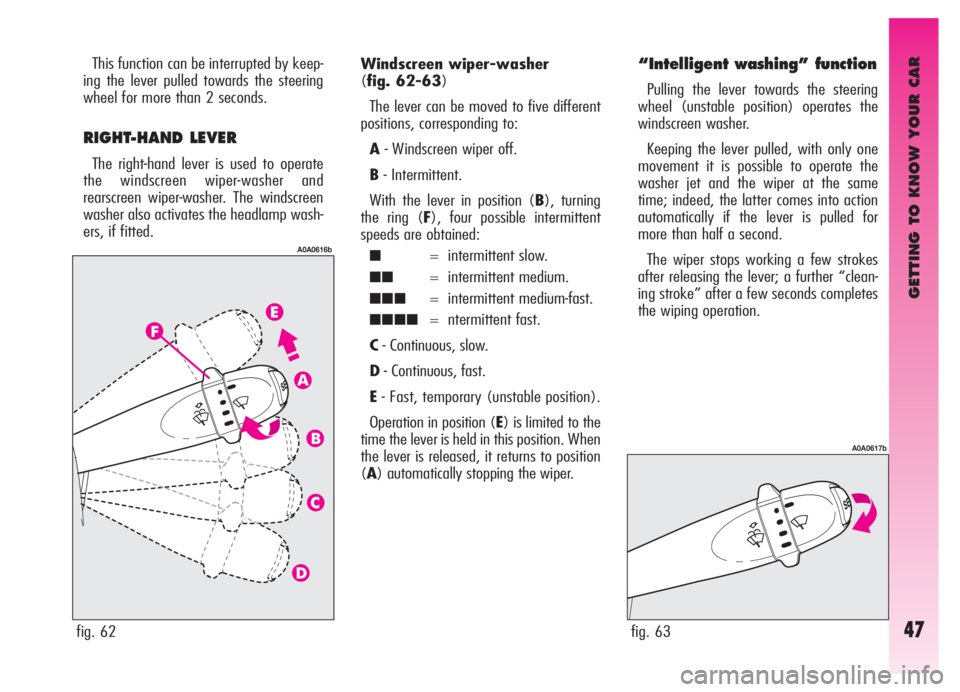
GETTING TO KNOW YOUR CAR
47
This function can be interrupted by keep-
ing the lever pulled towards the steering
wheel for more than 2 seconds.
RIGHT-HAND LEVER
The right-hand lever is used to operate
the windscreen wiper-washer and
rearscreen wiper-washer. The windscreen
washer also activates the headlamp wash-
ers, if fitted.
fig. 62
A0A0616b
Windscreen wiper-washer
(fig. 62-63)
The lever can be moved to five different
positions, corresponding to:
A- Windscreen wiper off.
B- Intermittent.
With the lever in position (B), turning
the ring (F), four possible intermittent
speeds are obtained:
■= intermittent slow.
■■= intermittent medium.
■■■= intermittent medium-fast.
■■■■= ntermittent fast.
C- Continuous, slow.
D- Continuous, fast.
E- Fast, temporary (unstable position).
Operation in position (E) is limited to the
time the lever is held in this position. When
the lever is released, it returns to position
(A) automatically stopping the wiper.
“Intelligent washing” function
Pulling the lever towards the steering
wheel (unstable position) operates the
windscreen washer.
Keeping the lever pulled, with only one
movement it is possible to operate the
washer jet and the wiper at the same
time; indeed, the latter comes into action
automatically if the lever is pulled for
more than half a second.
The wiper stops working a few strokes
after releasing the lever; a further “clean-
ing stroke” after a few seconds completes
the wiping operation.
fig. 63
A0A0617b
Page 51 of 307
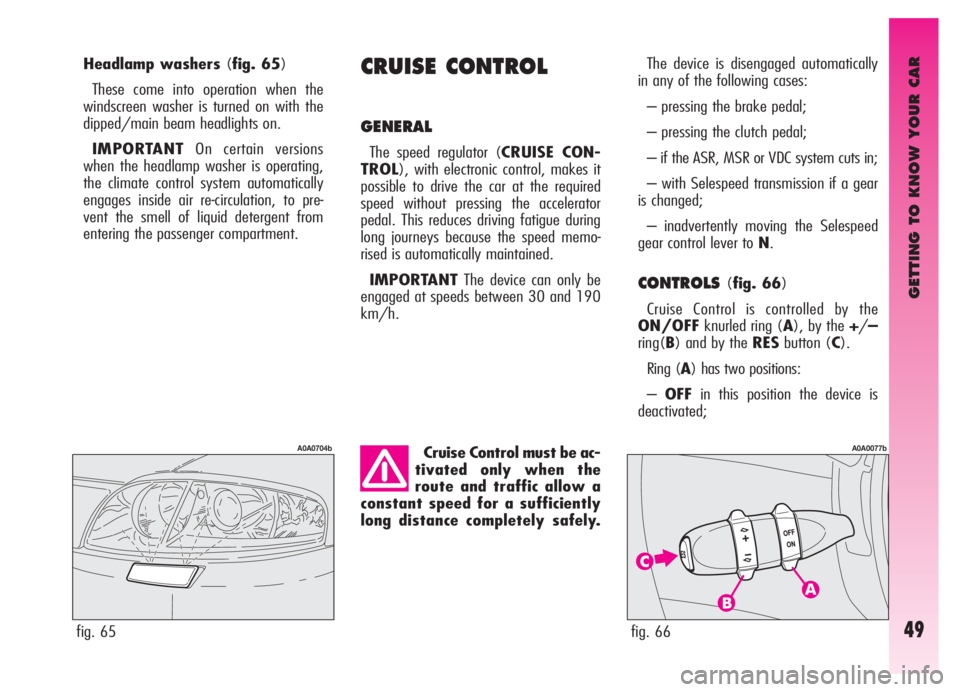
GETTING TO KNOW YOUR CAR
49
Headlamp washers (fig. 65)
These come into operation when the
windscreen washer is turned on with the
dipped/main beam headlights on.
IMPORTANTOn certain versions
when the headlamp washer is operating,
the climate control system automatically
engages inside air re-circulation, to pre-
vent the smell of liquid detergent from
entering the passenger compartment.CRUISE CONTROL
GENERAL
The speed regulator (CRUISE CON-
TROL), with electronic control, makes it
possible to drive the car at the required
speed without pressing the accelerator
pedal. This reduces driving fatigue during
long journeys because the speed memo-
rised is automatically maintained.
IMPORTANTThe device can only be
engaged at speeds between 30 and 190
km/h.
fig. 65
A0A0704bCruise Control must be ac-
tivated only when the
route and traffic allow a
constant speed for a sufficiently
long distance completely safely.
The device is disengaged automatically
in any of the following cases:
– pressing the brake pedal;
– pressing the clutch pedal;
– if the ASR, MSR or VDC system cuts in;
– with Selespeed transmission if a gear
is changed;
– inadvertently moving the Selespeed
gear control lever to N.
CONTROLS(fig. 66)
Cruise Control is controlled by the
ON/OFFknurled ring (A), by the +/–
ring(B) and by the RESbutton (C).
Ring (A) has two positions:
–OFFin this position the device is
deactivated;
fig. 66
A0A0077b
Page 54 of 307
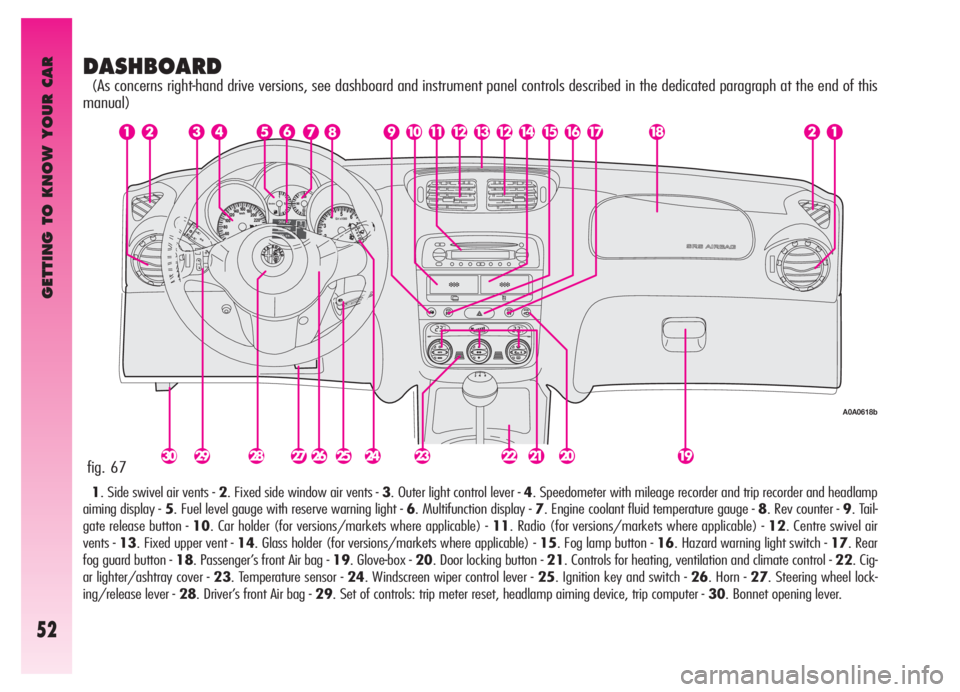
GETTING TO KNOW YOUR CAR
52
DASHBOARD
(As concerns right-hand drive versions, see dashboard and instrument panel controls described in the dedicated paragraph at the end of this
manual)
1. Side swivel air vents - 2. Fixed side window air vents - 3. Outer light control lever - 4. Speedometer with mileage recorder and trip recorder and headlamp
aiming display - 5. Fuel level gauge with reserve warning light - 6. Multifunction display - 7. Engine coolant fluid temperature gauge - 8. Rev counter - 9. Tail-
gate release button - 10. Car holder (for versions/markets where applicable) - 11. Radio (for versions/markets where applicable) - 12. Centre swivel air
vents - 13. Fixed upper vent - 14. Glass holder (for versions/markets where applicable) - 15. Fog lamp button - 16. Hazard warning light switch - 17. Rear
fog guard button - 18. Passenger’s front Air bag - 19. Glove-box - 20. Door locking button - 21. Controls for heating, ventilation and climate control - 22. Cig-
ar lighter/ashtray cover - 23. Temperature sensor - 24. Windscreen wiper control lever - 25. Ignition key and switch - 26. Horn - 27. Steering wheel lock-
ing/release lever - 28. Driver’s front Air bag - 29. Set of controls: trip meter reset, headlamp aiming device, trip computer - 30. Bonnet opening lever.
fig. 67
A0A0618b
Page 55 of 307

GETTING TO KNOW YOUR CAR
53
A. Fuel level gauge with reserve warning
light - B. Engine coolant fluid temperature
gauge with maximum temperature warn-
ing light - C. Speedometer - D. Odometer
display (mileage recorder, trip recorder with
headlamp position display - E. Reconfigu-
rable multifunction display - F. Rev counter
Petrol version
A. Fuel level gauge with reserve warning
light - B. Engine coolant fluid temperature
gauge with maximum temperature warn-
ing light - C. Speedometer - D. Odometer
display (mileage recorder, trip meter with
headlamp position display) - E. Reconfigu-
rable multifunction display - F. Rev counter
INSTRUMENT PANEL
Petrol versions
fig. 68 - 1.8 T. SPARK - 2.0 JTS
fig. 69 - 2.0 JTS Selespeed
A0A0656b
A0A0655b
Page 56 of 307

GETTING TO KNOW YOUR CAR
54
fig. 70 - 3.2 V6
fig. 71 - JTD 16V
Petrol versions
A.Fuel level gauge with reserve warning
light - B.Engine coolant fluid temperature
gauge with maximum temperature warn-
ing light - C.Speedometer - D.Odometer
display (mileage recorder, trip meter with
headlamp position display) - E.Reconfigu-
rable multifunction display - F.Rev counter
Diesel versions
A. Fuel level gauge with reserve warning
light - B. Engine coolant fluid temperature
gauge with maximum temperature warn-
ing light - C. Speedometer - D. Odometer
display (mileage recorder, trip meter with
headlamp position display) - E. Reconfigu-
rable multifunction display - F. Rev counter
A0A0687b
A0A0657b
Page 57 of 307
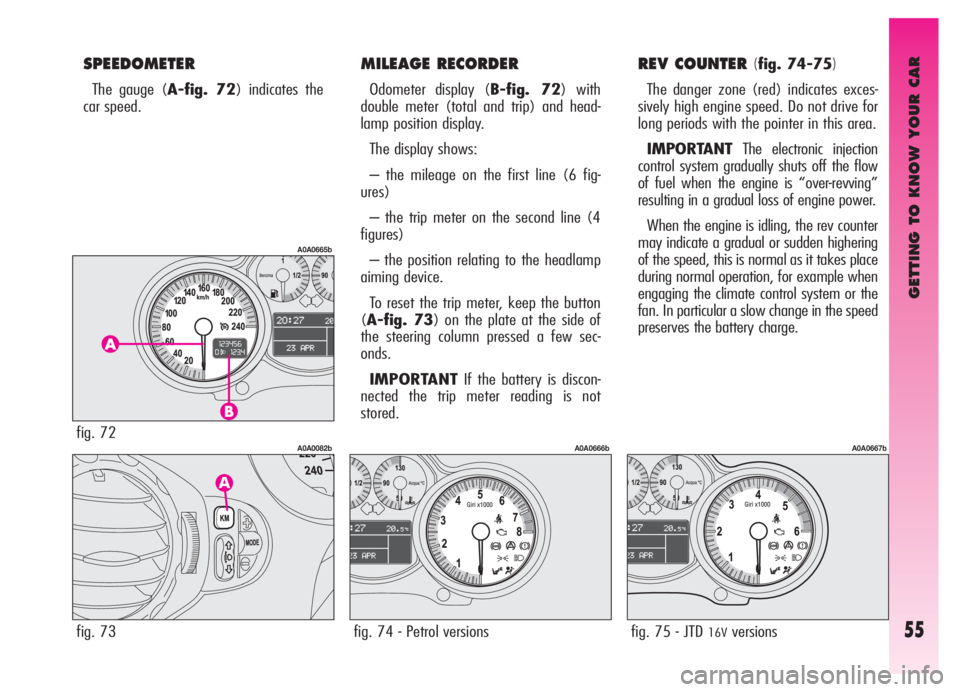
GETTING TO KNOW YOUR CAR
55
SPEEDOMETER
The gauge (A-fig. 72) indicates the
car speed.
MILEAGE RECORDER
Odometer display (B-fig. 72) with
double meter (total and trip) and head-
lamp position display.
The display shows:
– the mileage on the first line (6 fig-
ures)
– the trip meter on the second line (4
figures)
– the position relating to the headlamp
aiming device.
To reset the trip meter, keep the button
(A-fig. 73) on the plate at the side of
the steering column pressed a few sec-
onds.
IMPORTANTIf the battery is discon-
nected the trip meter reading is not
stored.
REV COUNTER (fig. 74-75)
The danger zone (red) indicates exces-
sively high engine speed. Do not drive for
long periods with the pointer in this area.
IMPORTANTThe electronic injection
control system gradually shuts off the flow
of fuel when the engine is “over-revving”
resulting in a gradual loss of engine power.
When the engine is idling, the rev counter
may indicate a gradual or sudden highering
of the speed, this is normal as it takes place
during normal operation, for example when
engaging the climate control system or the
fan. In particular a slow change in the speed
preserves the battery charge.
fig. 73
A0A0082b
fig. 74 - Petrol versions
A0A0666b
fig. 75 - JTD 16Vversions
A0A0667bfig. 72
A0A0665b
Page 61 of 307
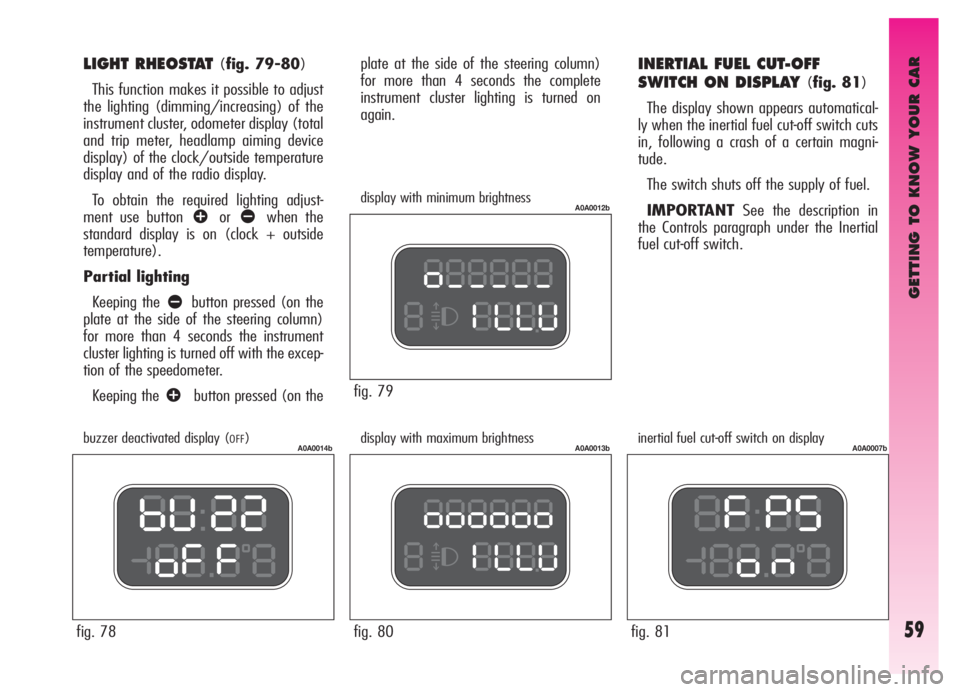
GETTING TO KNOW YOUR CAR
59
fig. 79
A0A0012b
fig. 80
A0A0013b
fig. 81
A0A0007b
plate at the side of the steering column)
for more than 4 seconds the complete
instrument cluster lighting is turned on
again.INERTIAL FUEL CUT-OFF
SWITCH ON DISPLAY
(fig. 81)
The display shown appears automatical-
ly when the inertial fuel cut-off switch cuts
in, following a crash of a certain magni-
tude.
The switch shuts off the supply of fuel.
IMPORTANTSee the description in
the Controls paragraph under the Inertial
fuel cut-off switch.
display with minimum brightness
display with maximum brightness inertial fuel cut-off switch on display
fig. 78
A0A0014bbuzzer deactivated display (OFF)
LIGHT RHEOSTAT (fig. 79-80)
This function makes it possible to adjust
the lighting (dimming/increasing) of the
instrument cluster, odometer display (total
and trip meter, headlamp aiming device
display) of the clock/outside temperature
display and of the radio display.
To obtain the required lighting adjust-
ment use button
âorãwhen the
standard display is on (clock + outside
temperature).
Partial lighting
Keeping the
ãbutton pressed (on the
plate at the side of the steering column)
for more than 4 seconds the instrument
cluster lighting is turned off with the excep-
tion of the speedometer.
Keeping the
âbutton pressed (on the
Page 85 of 307
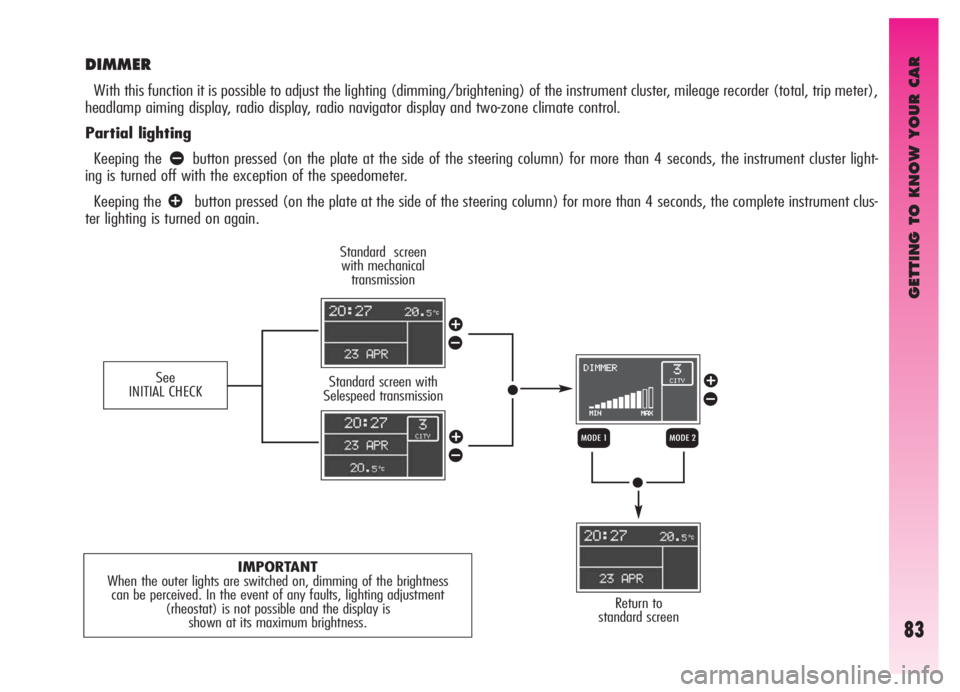
GETTING TO KNOW YOUR CAR
83
DIMMER
With this function it is possible to adjust the lighting (dimming/brightening) of the instrument cluster, mileage recorder (total, trip meter),
headlamp aiming display, radio display, radio navigator display and two-zone climate control.
Partial lighting
Keeping the
ãbutton pressed (on the plate at the side of the steering column) for more than 4 seconds, the instrument cluster light-
ing is turned off with the exception of the speedometer.
Keeping the
âbutton pressed (on the plate at the side of the steering column) for more than 4 seconds, the complete instrument clus-
ter lighting is turned on again.
Standard screen
with mechanical
transmission
Standard screen with
Selespeed transmission
Return to
standard screen
IMPORTANT
When the outer lights are switched on, dimming of the brightness
can be perceived. In the event of any faults, lighting adjustment
(rheostat) is not possible and the display is
shown at its maximum brightness.
QR
â
ã
â
ãâ
ã
See
INITIAL CHECK
Page 252 of 307
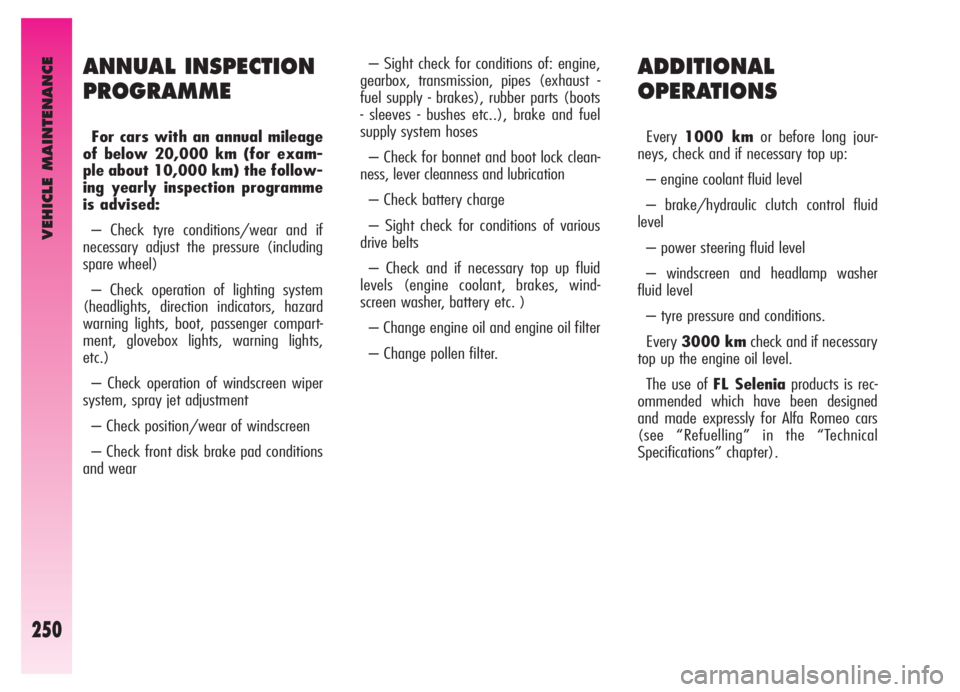
VEHICLE MAINTENANCE
250
ADDITIONAL
OPERATIONS
Every 1000 kmor before long jour-
neys, check and if necessary top up:
– engine coolant fluid level
– brake/hydraulic clutch control fluid
level
– power steering fluid level
– windscreen and headlamp washer
fluid level
– tyre pressure and conditions.
Every 3000 kmcheck and if necessary
top up the engine oil level.
The use of FL Seleniaproducts is rec-
ommended which have been designed
and made expressly for Alfa Romeo cars
(see “Refuelling” in the “Technical
Specifications” chapter).
ANNUAL INSPECTION
PROGRAMME
For cars with an annual mileage
of below 20,000 km (for exam-
ple about 10,000 km) the follow-
ing yearly inspection programme
is advised:
– Check tyre conditions/wear and if
necessary adjust the pressure (including
spare wheel)
– Check operation of lighting system
(headlights, direction indicators, hazard
warning lights, boot, passenger compart-
ment, glovebox lights, warning lights,
etc.)
– Check operation of windscreen wiper
system, spray jet adjustment
– Check position/wear of windscreen
– Check front disk brake pad conditions
and wear– Sight check for conditions of: engine,
gearbox, transmission, pipes (exhaust -
fuel supply - brakes), rubber parts (boots
- sleeves - bushes etc..), brake and fuel
supply system hoses
– Check for bonnet and boot lock clean-
ness, lever cleanness and lubrication
– Check battery charge
– Sight check for conditions of various
drive belts
– Check and if necessary top up fluid
levels (engine coolant, brakes, wind-
screen washer, battery etc. )
– Change engine oil and engine oil filter
– Change pollen filter.